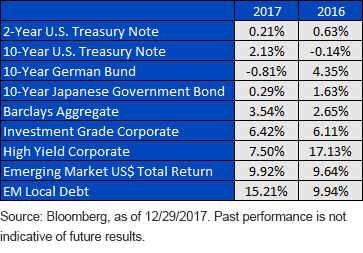Global Fixed Income: Putting a Bow on 2017


One month into the New Year and we’ve already seen some interesting—some might even say unexpected—developments in the bond market. Before we get too far into 2018, I thought it would be a useful exercise to offer a final review of how the major fixed income asset classes fared for 2017, in a sense providing some frame of reference for this year’s possibilities.
Perhaps the biggest surprise was found yet again in the U.S. Treasury (UST) market, specifically toward the back end of the curve. After posting a modest red-ink figure of -0.14% in 2016 (utilizing the Citi 10-Year Treasury Benchmark On-the-Run Index), the UST 10-Year note rebounded to register a total return in the plus column of +2.13%, defying expectations in the process. Indeed, following the 2016 presidential election, the overwhelming sentiment was that this rate instrument would have to finish the year higher in yield, but instead it closed out nearly 30 basis points (bps) below consensus forecasts (the fourth year in a row this happened).
Around the globe, two other closely watched developed world bond markets (Germany and Japan) did not share the U.S. experience. To be sure, 10-year German bund yields actually rose last year, helping to produce a -0.81% shortfall, while in Japan the same maturity registered an essentially unchanged performance (German and Japan generic government 10-year yield indexes).
Total Returns

The U.S. corporate bond market came in on the plus side of the ledger, with both investment grade (IG) and high yield (HY) posting back-to-back positive readings for 2016 and 2017. The IG performance basically matched the prior year’s positive return (+6.42% vs +6.11%, according to the Bloomberg Barclays U.S. Aggregate Corporate Total Return Value Unhedged Index). The HY sector put in another robust showing (+7.50%), especially considering it was coming off an incredible total return of +17.13% (as measured by the Bloomberg Barclays U.S. Corporate High Yield Total Return Index Unhedged) in 2016.
The emerging market (EM) debt space experienced the best performance within the fixed income universe during 2017, continuing to build on the positive momentum seen for 2016. To be sure, EM local debt produced a total return of over +15% (J.P. Morgan Government Bond Index – Emerging Markets Global Diversified Index), after posting nearly +10% for all of 2016. Interestingly, these consecutive positive returns have represented a complete turnaround from where EM local debt was in 2015, when it printed a hefty shortfall of almost -15%.
Conclusion
Given where many fixed income asset classes currently reside in terms of relative value, it would seem difficult to expect such robust repeat performances as are highlighted in this blog post. Fixed income investors will more than likely need to be a bit more discerning in their investment approach and should consider the potential benefits of fundamental—or smart beta—fixed income strategies, a field where WisdomTree is a pioneer.
Unless otherwise noted, data source is Bloomberg as of December 29, 2017.
Important Risks Related to this Article
Fixed income investments are subject to interest rate risk; their value will normally decline as interest rates rise. In addition, when interest rates fall, income may decline. Fixed income investments are also subject to credit risk, the risk that the issuer of a bond will fail to pay interest and principal in a timely manner or that negative perceptions of the issuer’s ability to make such payments will cause the price of that bond to decline.


